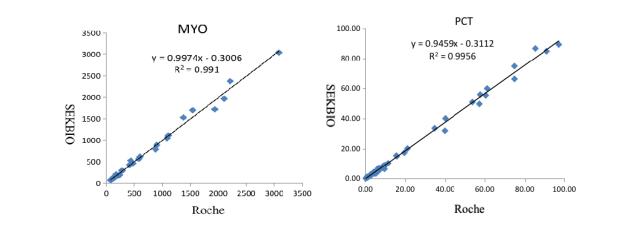CLIA/ELISA development
Comprehensive Portfolio of CLIA items
More than 70 parameters are ready—myocardial markers, Inflammation, gastric function, etc.

Introduction of CLIA
Chemiluminescence immunoassay is a combination of chemiluminescence and immunoassay. It has both the high sensitivity of chemiluminescence and the high selectivity of immunoassays. The combination of the two is achieved by labelling chemiluminescence reaction reagents (such as acridinium ester, alkaline phosphatase, etc.) with antibodies or antigens, and the labelled antibodies or antigens undergo a series of immunoreactions with the analyte. Washing, etc.), and finally, determining the luminescence intensity to determine the analyte's content indirectly.
The main chemiluminescence immunoassays can be roughly divided into three categories according to their markers, direct chemiluminescence, enzymatic chemiluminescence, and electrochemiluminescence.

Direct chemiluminescence uses luminescent molecules, such as acridinium esters, luminous, etc., to label antibodies or antigens. The characteristics of this type of small molecule are that they can be excited to emit light under specific conditions, so they are called direct chemiluminescence. It is usually used for direct chemiluminescence labelling of molecules such as acridinium esters, which have smaller molecular weights and fewer changes to antibody antigens during the labelling process.
Another widely used is enzymatic chemiluminescence. Enzymatic chemiluminescence couples horseradish peroxidase (HRP) or alkaline phosphatase (AP) to antibodies or antigens. After the immune reaction, the enzyme catalyzes the substrate to emit light, often called indirect chemiluminescence.
The most commonly used label in electrochemiluminescence is ruthenium bipyridine [Ru(bpy)3]2+ and its derivatives. On the working electrode, the tripropylamine in the reaction system becomes the radical tripropylamine with substantial reducing property, and [Ru(bpy)3]2+ releases electrons to become the trivalent [Ru(bpy)3]3 with the strong oxidizing property. +. The two then undergo a redox reaction, releasing a photon with a wavelength of 620 nm. The reaction process is cyclic, and the measurement signal is continuously amplified.
We rolled out the relevant chemiluminescence immunoassay (CLIA) reagents based on the in-house production of high-quality antibodies.
The consistency of Myo/ PCT/ TSH and IL-6 reagents is 99% with benchmark products.


We suggest you use those reagents with our CLIA analyser.
Comprehensive Portfolio
More than 50 parameters are ready—myocardial markers, Inflammation, gastric function, etc.
High Sensitivity
The sensitivity of IL-6, Nt-proBNP, and cTnL parameters attains 1 pg/mL.
High Repeatability
5% below CV for most parameters.
To establish your CLIA products line now: Sales@sekbio.com
- Cardiac Markers
-
Tumor Marker
-
PGII
-
G17
- CA50
-
CA125
- CA242
-
CA15-3
- CA19-9
- CA72-4
-
Pepsinogens I (PGI)
-
Human Epididymis 4 (HE4)
- Prostate-Specific Antigen (PSA)
- Squamous Cell Carcinoma (SCC)
- Neuron-Specific Enolase (NSE)
- Cytokeratin 19 Fragment (CYFRA21-1)
- Human Progastrin-releasing Peptide (ProGRP Tumor Marker)
- Protein Induced by Vitamin K Absence or Antagonist-II (PIVKA II Tumor Marker)
- Alpha-fetoprotein(AFP)
-
CEA
-
Human Chitinase 3-like 1
-
PGII
- Inflammatory Marker
- Infectious Disease
- Hormones
- Thyroid Function
- Glucose Metabolism
- Bone Marker
- Others
-
Heterophilic Blocking Reagent
- Animal Diagnostics














